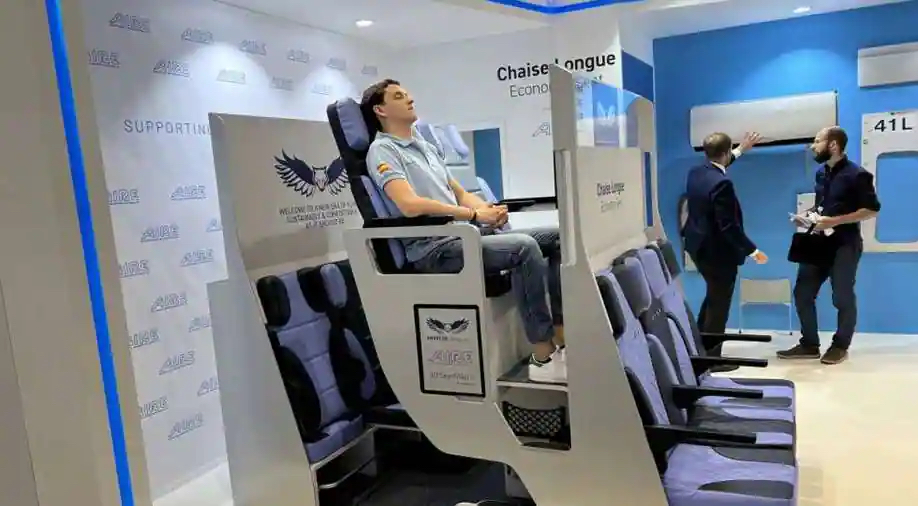Why you’ll never fly in an airplane with those double-decker seats

Regular travelers know all too well just how uncomfortable airplanes have gotten over the last few years. Seats are narrower and offer less legroom than they have in years past, and as prices rise, thanks to the perfect storm of inflation and corporate greed, flying economy feels more like some form of modern torture to be endured than a luxurious experience. Add in the terrifying double-decker and standing-room-only seat configurations that airliners and designers are attempting to sell to the paying public, and the picture of the future of airline travel only gets bleaker.
Take the most recent hubbub around designer Alejandro Núñez Vincente’s so-called Chaise Longue setup, which has made its second, updated appearance at the Aircraft Interiors Expo in Hamburg, Germany, this week. We may have just reached peak uncomfortable airline seating.
Don’t believe us? Media outlets are running stories about what happens when someone farts in these seats. But before we declare the end of human-oriented economy airline travel or wring our hands in dismay at just how many people are packed into flying jerky-makers in the sky, we decided to do some digging and find out why these designs are unlikely to take off (pun fully intended).
A variety of configurations
The standing seat has been around for more than 20 years. Airbus was the first to pioneer the idea of standing seats and filed a patent for them in 2015. In 2019, an Italian design house called Aviointeriors showed off a bicycle-style upright seat called the Skyrider, which had poles attaching each row to the airplane’s interior. While it caused plenty of angst in the travel community and made a couple of budget airline CEOs float the idea of installing them (we’re looking at you, Ryanair and Spring Airlines) these seats never took off and are simply not going to fly.
The idea of stacked seating has been around for many years, with patents going back as far as 1948. Some have included everything from outward-facing seats to bunk beds, honeycomb-style seating, and seats that look more like yoga manuals than seating configurations. The latest is the double-decker Chaise Longue setup that reappeared this week.

FAA regulations
Here in the US, the Federal Aviation Administration is in charge of regulating all civil aviation. There are plenty of rules that deal directly with seating and emergency exit access, the number of flight attendants needed per passenger, and the physical requirements that seats must adhere to in “emergency landing dynamic conditions,” but none of these regulations specifically address the issue of comfort or personal space in airplane seating.
But if airlines decide to try double-decker or standing seats, those setups will have to stand up to, and meet, stringent (if old) FAA standards, like this bit from that emergency landing dynamic conditions regulation mentioned above:

In stacked seating, the heads of the passengers on the bottom tiers are precariously close to the seats of those on the top tiers, which could cause serious injury in the event of an emergency maneuver. The same would be true with standing seats since they are spaced so closely together from front to back, and passengers’ heads would be much closer to the fuselage of a plane when using a standing seat.
Then there’s the political wrangling around airplane seating. Late last year, the FAA opened a session for comments on seat sizes on flights and was flooded with more than 26,000 comments before it was closed, and the major carriers threw a tantrum about the idea of minimum seat sizes.
Just last month, Democratic Senator Tammy Duckworth reopened the issue and introduced S.1765, legislation that would curb the increasingly shrinking airplane seat. Duckworth is a decorated, retired Army National Guard lieutenant colonel and the first woman with a disability to be elected to US Congress.
According to The Washington Post, the bill has the backing of pilot and flight attendant unions and passenger and medical advocacy groups, and it would require a reassessment of 2018 evacuation rules that call for passengers to be able to evacuate in 90 seconds. Current FAA testing is done with non-disabled passengers with no carry-ons. The FAA administrator admitted that these tests were “useful but not necessarily definitive.” The new bill would require the FAA to consider and test how easily people of different heights, sizes, ages, and mobility could quickly and safely evacuate a plane and add considerations for darkness, smoke, and carry-ons. The bill is currently in committee.
https://arstechnica.com/?p=1946055